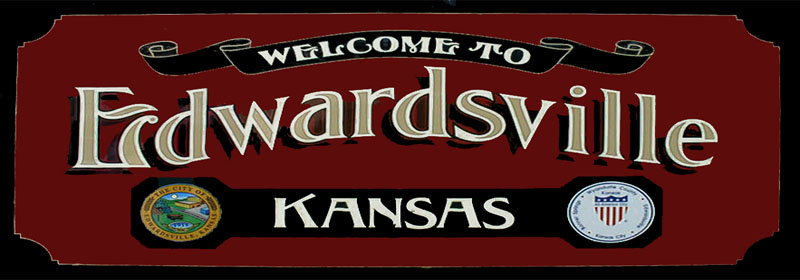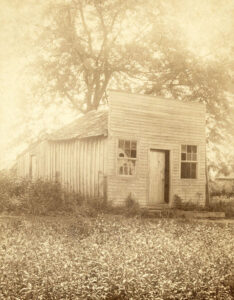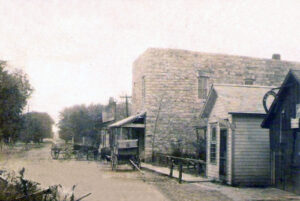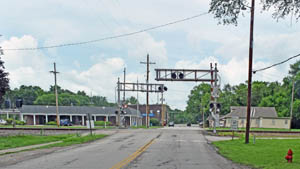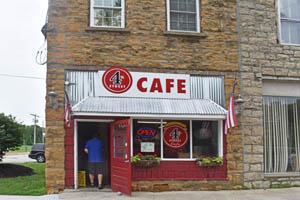Edwardsville, Kansas, is located in southwest Wyandotte County, just north of the Kansas River and south of the Kansas Speedway. Part of the Kansas City Metropolitan Area, it had a population of 4,717 as of the 2020 census.
A Delaware Chief named Half-Moon was the original owner of the land where downtown Edwardsville now stands.
In 1837 Ira D. Blanchard founded the Delaware Baptist Mission in the area. That year, a newly-ordained Baptist pastor from Massachusetts, the Reverend John Gill Pratt, came to Kansas and began working with different missionary societies. In 1844 he settled at Edwardsville, working for the Baptist Missionary Society, and started a boarding school patronized by the Delaware Indians. The original mission building was destroyed by flood waters around 1844. Reverend John Gill Pratt was given charge of the Delaware Baptist Mission in 1847. Logs from the original building were then used to build a replacement structure farther inland in 1848.
On September 10, 1850, a post office called Delaware was established in the area. On February 1, 1856, the post office’s name was changed to Secondine. The post office closed on April 14, 1859.
In 1864 Reverend Pratt became a United States Indian agent to the Delaware Indians, serving in this capacity until about 1868. The Delaware were then moved to Indian Territory (Oklahoma). After the Delaware Baptist Mission was abandoned, the mission buildings fell into ruin and were soon gone.
Another post office was moved here on January 9, 1867, from Tiblow (now Bonner Springs.) It was called Edwardsville for John H. Edwards, a general passenger agent for the Union Pacific Railroad. He would later serve as a justice of the peace and state senator from Ellis County, Kansas.
At some point, Delaware Chief Half Moon sold his land to General T. Smith of Leavenworth, Kansas, and others, who sold it to William Kouns. A Methodist Episcopal Church was organized in 1868 with a large membership. The same year, the town of Edwardsville was created through the influence and direct labors of William Kouns and the County Commissioners. It was surveyed in 1869.
In 1870, the Christian Church was organized here. By then, the Methodist Episcopal Church had disbanded because many of its members had moved away.
By the early 1880s, several neat little stations and hamlets were scattered throughout the county, with the largest being Edwardsville, located about 14 miles west of Wyandotte, on the Union Pacific Railroad. At that time, the town consisted of 30-40 dwellings, several business houses, a good depot, and a fine school.
In the early 1900s, one of the City’s most famous residents was Junius Groves, a freed slave known as the Potato King of the World because his western Wyandotte County farm produced more bushels of potatoes per acre than any of his international competitors. Groves was also one of the wealthiest African Americans in the nation. His holdings were estimated to be worth $80,000 in 1904, and by 1905, his holdings included more than 500 acres. By 1915, His holdings were estimated to be worth $300,000.
In 1910, Edwardsville was still located on the Union Pacific Railroad. As the center of the great potato and fruit-growing industry of Wyandotte County, hundreds of cars of these and other products were shipped annually from this station. At that time, the town had a fine brick schoolhouse, a bank, several general stores, a blacksmith and wagon shop, a good depot, a telegraph office, a telephone exchange, and a population of 209.
The City was officially incorporated in 1915.
In the following decades, Edwardsville continued to grow.
On July 29, 1971, its post office was classified as a branch of Kansas City, Kansas.
Today, Edwardsville is part of a unified local government, which contains Kansas City, Kansas, a portion of Bonner Springs, and about one-quarter of Lake Quivira.
The City of Edwardsville maintains a full scope of emergency services. It has a police department with officers on duty 24 hours a day, 365 days a year. The fire department serves the citizens and visitors of the cities of Edwardsville, Bonner Springs, and western Kansas City. It is staffed by 17 full-time, seven part-time personnel, and five volunteers. The department has fire code inspectors and provides advanced life support through its two ambulances.
The community is served by Bonner Springs–Edwardsville USD 204 public school district.
Edwardsville offers a small-town feel with close proximity to metropolitan amenities and attractions.
It is about 13 miles southwest of downtown Kansas City, Kansas.
©Kathy Alexander/Legends of Kansas, updated October 2023.
Also See:
Sources:
Blackmar, Frank W.; Kansas: A Cyclopedia of State History, Vol I; Standard Publishing Company, Chicago, IL 1912.
Cutler, William G; History of Kansas; A. T. Andreas, Chicago, IL, 1883.
Edwardsville, KS
Kansapedia
Morgan, Perl W.; History of Wyandotte County, Kansas and Its People, Lewis Publishing Company, Chicago, IL, 1911
Wikipedia

